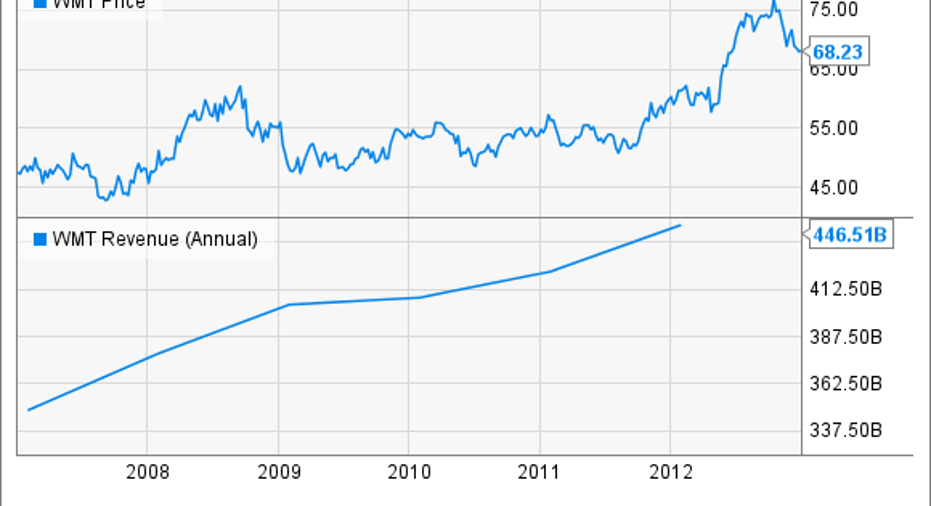Worried About Dow 20,000? Here's How to Play Defense With Your Portfolio

The Dow Jones Industrial Average has been flirting with the 20,000-point milestone for several weeks and just can't seem to get over the hump. While the level of 20,000 doesn't really mean much, as I've written before, it does reinforce the fact that we're eight years into a bull market -- the second longest in history. This doesn't mean a correction is right around the corner, but it might be a good idea to set your portfolio up to profit in good times and bad.
Image Source: Getty Images.
Focus on defensive stocks
Some companies (and their stocks) simply fare better during rough times than others.
A great example to illustrate this concept is in the retail sector. When times get rough, people tend to cut back on unnecessary and higher-end purchases, which is why companies such as Tiffany & Co. often perform poorly in recessions.
On the other hand, companies such as Wal-Mart (NYSE: WMT) and Family Dollar thrive during recessions. Take a look at this chart of Wal-Mart's performance from 2007 to 2012. Notice how sales rose every year, even though the economy was in awful shape during some of those years. And the stock price rose by 20% in 2008 while the S&P 500 lost nearly 38%. (Tiffany & Co. lost 46%)
Businesses such as Wal-Mart and Family Dollar work well no matter what the economy is doing. In prosperous times, existing customers have extra money to spend. And in rough times, consumers have less money to spend, but people who normally shop at higher-end retailers cut back on spending, so the customer base grows.
There are defensive businesses like this in many sectors that provide products and services people need no matter what the economy is doing, so if you're looking for stocks to buy now, this could be the way to go.
Dividend growth stocks can limit losses
Dividend-paying stocks tend to do better during turbulent times than their non-dividend counterparts. And dividend stocks that have an excellent track record of growing their payouts tend to do even better.
One reason is that these stocks' dividends are seen as being extremely reliable and can help to prop up a stock's price. Without getting too mathematical, the lower a dividend stock's price gets, the better its yield will be. If the yield gets high, investors who want safe income start buying shares and create upward pressure on the stock.
A smart way to play it is with an ETF that tracks a dividend growth index, such as the ProShares S&P 500 Dividend Aristocrats ETF (NYSEMKT: NOBL), which invests in 50 companies that have all increased their dividends for 25 consecutive years or more. The fund has a relatively low 0.35% expense ratio and pays a dividend yield of around 2%.
Keep some cash on the sideline
There's no way of knowing what the market will do next week, next month, or next year. Trying to time the market is a losing battle.
Having said that, with some basic knowledge, it's not too difficult to spot stocks that are already on sale. So if you think stocks may be a bit too expensive, or if you think we're simply heading for some volatility, keeping some cash on the sidelines can be a great way to scoop up bargains as they come.
As a personal example, the market was highly volatile toward the beginning of 2016, so I decided to take a breather from buying stocks and let some cash build up in my account. This move paid off -- when bank stocks cratered in February, I was able to scoop up shares of Goldman Sachs for about $150, and Bank of America for about $12.
Here's the important point -- both of these stocks continued to fall after I bought them. Goldman fell about $10 shortly after I bought it, and Bank of America eventually bottomed out at less than $11. However, both had become extremely cheap from a long-term perspective, so I didn't panic. Now, Goldman trades for about $244 and Bank of America is around $23, which translates to gains of 63% and 92%, respectively, neither of which would have been possible if I had been 100% invested when the market got a little choppy.
So as we head into a largely uncertain 2017 on the heels of a big market rally, it may be a good idea to start building up a little cash. Doing so makes market volatility your friend, not your worst nightmare.
10 stocks we like better thanWal-MartWhen investing geniuses David and TomGardner have a stock tip, it can pay to listen. After all, the newsletter theyhave run for over a decade, the Motley Fool Stock Advisor, has tripled the market.*
David and Tomjust revealed what they believe are theten best stocksfor investors to buy right now... and Wal-Mart wasn't one of them! That's right -- theythink these 10 stocks are even better buys.
Click hereto learn about these picks!
*StockAdvisor returns as of December 12, 2016The author(s) may have a position in any stocks mentioned.
Matthew Frankel owns shares of Bank of America and Goldman Sachs. The Motley Fool has no position in any of the stocks mentioned. The Motley Fool has a disclosure policy.